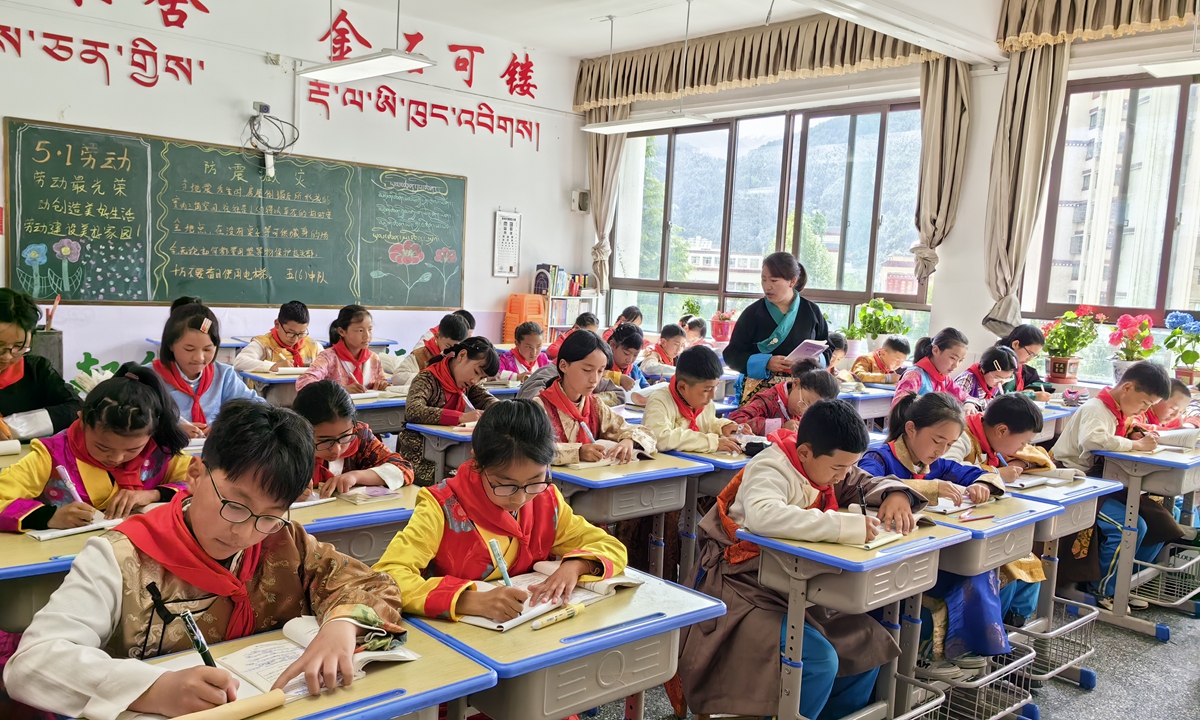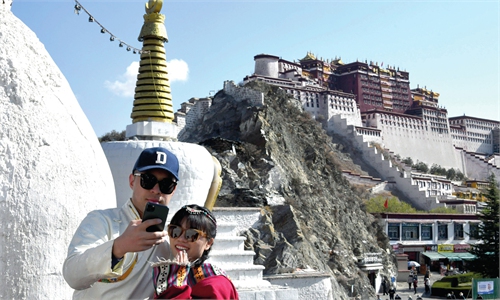My first-hand observation of Xizang education proves West’s slander, distortion wrong

Students at Nyingchi No.2 Primary School are having a class. Photo: Courtesy of Roland Boer
To begin with a simple statistic: before the peaceful liberation of Xizang (Tibet) in 1951, literacy was less than 5 percent of the population; today, literacy is more than 95.5 percent. Before 1951 education was only for the children of the aristocratic ruling elite; after liberation, education became available for everyone. However, achieving universal literacy did not happen overnight. It required much hard work and much-targeted funding in education, especially in light of Xizang's remote and high-altitude terrain.During a week in May of this year, I was able to inspect first-hand some of the results of all this hard work. I was part of a research field trip, which was sponsored and organized by the State Department Information Office of China. In a very busy daily schedule, of great importance were our visits to a primary school and middle/high school. Our visits also included many conversations about education across Xizang.
On the third day of our field trip, we visited Nyingchi (Linzhi) No. 2 Primary School, initially founded in 1971. We were free to enter and spend time in classrooms while lessons were underway (science, literature, Xizang calligraphy, mathematics, English language, and so on), watch children practicing Xizang dances, participate in the physical education class on one of the sports fields, and watch one of the teachers of Xizang calligraphy show us how it is done. In fact, I am the proud possessor, a beautiful example of his calligraphy - a gift. By now, it should be obvious that this is a minzu (ethnic) school that teaches children about the rich cultural heritage of their area, while at the same time preparing them to enter confidently into the modern world of China as a whole.
While experiencing all these educational activities, I paid attention to the grounds and buildings. Set against a stunning backdrop of snow-capped mountains, the quality and upkeep of the buildings was obvious, as were the state-of-the art facilities in the science labs, multimedia rooms, and recording and broadcasting room. Outside, there was careful attention to green space for the children, with 2000 square meters full of trees, shrubs, flowers and grass.
The next day, we travelled on the newly-completed leg of the high-speed rail line to the higher city of Lhasa. Not long after arrival, we visited the Beijing Experimental High School, which includes both lower and higher middle school education for 2,434 students. Again, we were free to examine many educational activities, but I would like to note two specific features of this school.
The first is the policy of pairing, in the sense that a region with significant educational resources pairs with a region that faces more challenges so as to improve the latter's educational level. This is precisely what happened with Beijing Experimental High School. When it was initially founded in 1978, it was known as Lhasa No.3 Middle School, combined with Lhasa No.2 High School. However, with a new round of reforms aimed at improving education in Xizang further, in 2014, the old school was paired with Beijing and its rich educational resources. A new campus and a new name were only the beginning. Since 2014, study tours to other parts of the country have been organized, and 167 outstanding teachers in four groups have volunteered to come from Beijing to assist in raising the quality of education further.
The second feature was our visit to one of the dormitory buildings for students from further afield. For someone who was raised in a Western country, with its liberal ideology and the idea of a "room of one's own," the common and assumed practice across China of dormitory-style accommodation at all levels of education interests me greatly. What would it be like, I wonder, to have spent my high school and university years sharing my sleeping and living quarters with others of my own age? Would I have learned more about what it means to live in harmony with one another? Would I have learned better to understand the needs of others above those of myself? On this visit, I once again asked myself these questions. By way of answer, I noted carefully the great emphasis on precisely the virtues that come from deep in the Chinese, and indeed Xizang, cultural tradition: benevolence, righteousness, propriety, wisdom, and fidelity. These are no easy tasks and take a lifetime to learn; the dormitory is a good place to begin.
Now, someone who has unfortunately been influenced by the rounds of Western attempts to slander and distort China's monumental efforts in Xizang might ask: "Weren't you simply shown some 'model' schools and kept away from other poor schools?" By way of reply, let me mention a conversation at one of the schools. About a decade ago, one aspect of a new round of educational reforms was to close many small village schools in the high-altitude countryside in Xizang. Teaching quality in these small schools was still of poor quality. Instead, the children were required to travel to the nearest regional center to attend a newer and better-quality school. However, in some cases, this meant a round trip for the child of two hours each way, due to the still inadequate infrastructure in remote areas. Sometimes grandparents had to take the children, or they had to board at the school already at a young age. Ten years later, the same trip takes 20 minutes by bus each way.
Not only does this information tell us something about a problem-based approach to educational improvement across all of Xizang, but it also indicates the need for a comprehensive approach. Here it was the need to consider both education and infrastructure.
One final experience: as our group was leaving the dormitory at the Experimental High School, students began passing by us on their way back from the dining hall. They called out to us, saying "hello," joking and laughing. Some were very keen on the opportunity for a photograph with our small group. Clearly, they were enjoying their education, but they also had notable ease and youthful confidence. After all, the future of Xizang, as of the whole of China, is in their hands.
The author is a Marxist scholar from Australia, overseas talent professor in the School of Philosophy at Renmin University of China, and on the editorial board of the Australian Marxist Review. opinion@globaltimes.com.cn


